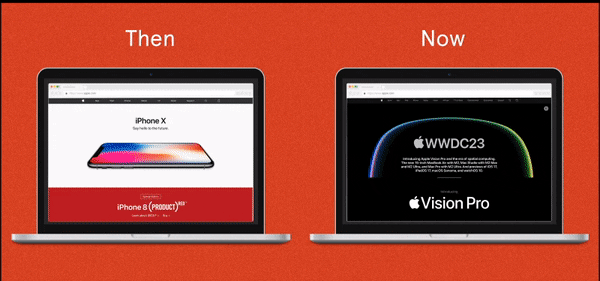It’s true, you are not imagining it, websites lose their edge after a few years. No matter how good your website is when you first build or redesign it, even the best websites naturally become outdated after about four or five years. This is due to a number of factors, such as Google updates, changing consumer needs, changing technologies, new platforms being introduced, and more.
Updating your website to keep it performing optimally can be a painstaking task, but the cost of letting this centerpiece of your company’s digital presence run down is even more painful. An underperforming website that doesn’t meet consumer needs and expectations creates a negative impression of your brand and can create a serious threat to your business.
How can you know if your website needs to be updated? Well, you might get direct complaints from your customers, your stakeholders may be making some snarky comments about your competitor’s website or you might notice some issues yourself as you poke around your own website, but if those things are happening, that’s likely just the tip of the iceberg. There is one key indicator — a group of indicators, really — that your website is struggling.
Read: Why We Use Google’s HEART Framework
The Biggest Sign You Have a Problem? Your Website’s Performance Has Been Slipping… Probably for a While
The most common symptom that your website has a serious issue (or several serious issues) is that the traffic is heading downward despite any significant change in your marketing tactics. And it’s not just for the last few weeks, but for the last few months — or longer. Is this a serious, structural problem?
How to Assess Your Website’s Health
To understand how your website is performing, you can use various analytic tools and specific metrics to dig into your website’s performance as well as that of your competitors.
- Run a Site Audit with a tool like SEMrush or Screaming Frog as your first step in assessing your website’s health. These platforms will give you a qualitative rating of your website’s overall health, identifying common issues like slow page-load times, duplicate content, and broken links. A handful of issues is not necessarily a problem. But if this audit returns a very low rating and a whole raft of issues, you might have a larger problem that only a website redesign can adequately address.
- Google Analytics will obviously tell you how your traffic is performing, and you’ll want to check out a few specific reports and key metrics.
- Organic Traffic. Drill down to the traffic sources, isolating organic search traffic. Has this been declining for months on end? If so, you’ve got a problem.
- Search Console. Dig deeper into your organic traffic here, analyzing the search terms that display your website to users in Google search results and the clickthrough rates for those searches.
- User Flow. This report shows where people come into your website, where they go to next, and where they typically drop off. There’s a lot to analyze here, but in short, if they drop off very quickly after arriving on-site or don’t flow through the site as you intended, you’ve got an issue.
- Bounce Rate. Similar to User Flow, high bounce rates indicate that users aren’t finding what they’re looking for on your website. If this is happening on key pages where you would hope for next clicks or conversions to take place, that’s a problem.
- Time On Page. A low time on page for the homepage or a landing page combined with a low bounce rate isn’t a problem — it suggests users quickly found what they were looking for and clicked through. But a low time on page for key pages — and particularly a low time on page combined with a high bounce rate on key pages — is a big red flag; the more pages on which this is happening, the bigger and redder that flag.
- Conversions. You ideally have conversions set up for tracking in Google Analytics. If these are low or declining, and you confirm that conversion tracking is set up properly, then you’ve got a deeper problem with user experience on the site.
- Hotjar is a tool that enables you to see how users act once they are on your site, giving you visual heat maps of their activity on the page. Depending on how much traffic your website or its various pages receive, it can take a few days to a few weeks to get useful data, but once you have it, you’ll be able to see where they go, what they click on, and where they drop off. The feedback comes in forms of videos so the website owner can observe them on an easy-to-understand platform and initiate changes.
- Competitor Comparisons. In addition to getting your own information, check out how your competitors are performing with tools like SEMrush or SimilarWeb which provide estimated traffic projections, SEO analysis, and comparative analytics between your website and theirs.
Reasons Your Website Might Be Underperforming
All of the above tests and analyses can reveal a number of potentially interrelated issues and reasons that your website is underperforming, and may need to be redesigned.
- Your website’s architecture isn’t working.
The symptoms: High bounce rates and unintended dropoffs in user flows are two key indicators that the site’s structure is out of whack and/or that the user experience is outdated or poorly designed.
The underlying problems: Mental models (our own explanation on how things work) evolve constantly as they are heavily influenced by our own experiences inside and outside of the digital world. Navigation and information architecture are mainly driven by the perception of how things are organized and users tend to try to replicate this organization inside the web. It is quite likely that your navigation menu may not meet your current user expectations or needs in terms or where they expect to find content or how they expect your journey to be.
- The UX of your website has become outdated.
The symptoms: Users tend to use Google search instead of your own website search functionality for finding content in your website or they may be contacting you over email or the phone requesting information that it is available online. Your conversion rate may be dropping even though you haven’t introduced any dramatic changes in your acquisition journeys.
The underlying problems: If you are familiar with Jakob’s Law, you may already know that users are much more likely to be influenced by other websites than by yours, just because they spend more time on them. Users may expect certain components to be clickable and they are not or they may expect components that allow them to skip steps or filter results further and feel like they are not in control. Furthermore, accessibility standards evolve with the technology updates and require for your website to be updated to stay compliant.
- Digital waste has piled up.
The symptoms: Slow page-load times; pages not optimized for mobile utility, accessibility audit issues.
The underlying problems: Javascript libraries or CSS files that are no longer needed or used; videos or images used for content that is no longer applicable or even available.
- You are maintaining unvisited content.
The symptoms: Your content audit reveals pages upon pages that get little to no traffic – – old blogs that are no longer relevant, pages with broken outgoing links or broken images, perhaps ancient calendar listings that have their own urls, or too many results shown when looking for simple terms in your search functionality. This is another form of digital waste.
The underlying problems: If they’re not driving organic traffic, all those pages of content are hurting your SEO, not to mention they are making your website more complex and cumbersome and taking up space on a server somewhere.
- Design elements are outdated.
The symptoms: You’ll get your first sense of this from the general declining nature of your website’s performance, but this will likely come into stark relief through competitor analysis.
The underlying problems: What seemed like great designs and graphics the last time you upgraded your website may seem tired now. If your design is reminiscent of the early internet days, with aged fonts, hard-to-read sections, or a lack of today’s web design best practices, it’s time for an update. It’s also possible your brand needs a refresh that can invigorate all aspects of your marketing, including your website.
- There’s a fundamental disconnect between your business and your website’s users.
The symptoms: Any combination of the above-listed factors like low engagement, high bounce rates, and declining search traffic could signify a more fundamental problem that goes beyond your website.
The underlying problems: It’s not always a design or UX issue. Maybe people leave your website without taking action because the web experience is bad, or maybe it’s because the messaging is outdated, no longer reflecting the needs of who you thought your customer was – maybe they have changed, or maybe your business objectives have.
Read: What K-Pop Teaches As About Good UX and Marketing
How a Website Redesign Addresses All of These Issues
A website redesign is about a lot more than just making it look pretty (though that’s important, too). But a thorough redesign involves a lot of background research that will confirm and clarify your audience’s needs and expectations and customer journeys; your business goals and objectives; what are the current usability challenges and delighters and how you stack up with your competitors. It will map out the marketing and content strategies and tactics that will flow through your website and extend to other digital channels. That fundamental work will lay the groundwork for all of the more technical work to come.
Read: Content Personalization Tools for Your WordPress Website
And the good news is that you may not even need a website redesign based on what you find from digging into the data, as we outlined above. Maybe it’s just some improved metadata on key pages, a few light dev fixes, or a revamp of one or two key pages or sections of the site.
But if the issues seem like they’re piling up and cascading, you might need to consider a redesign.
So, if you haven’t dug in deeply to your website’s analytics recently (though hopefully you do on a regular basis), and it’s been four or five years since your last major update, now might be the time to grab a cup of coffee and get to work.




